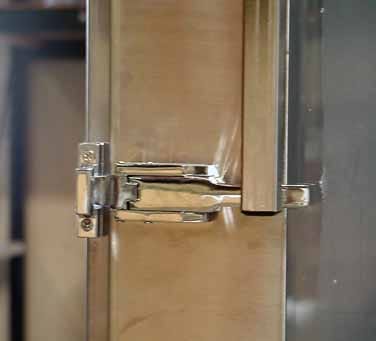Door Alignment
Proper alignment of doors will prevent excessive gas escape and ensure door sensor alignment. Some leakage, however, is normal. Because cabinets operate under varying degrees of positive pressure, Terra door gaskets are designed to allow controlled gas escape.
All cabinets are checked prior to packaging to ensure proper door alignment. However, they can come out of alignment during shipping due to the inherent flexibility of plastic.
Doors feature sensor magnets that must be aligned with the associated sensor on the desiccator door. If these magnets are misaligned, the Dual Purge™ system may not function properly, and door seals may not seat properly, allowing nitrogen leakage.

On a properly aligned, level cabinet, all door latches are engaged directly in the center of the corresponding catch (see photos).
- Open all doors.
- Make sure that the bottom of the cabinet is level. Use the leveling feet of the stand or shims to level the bottom of the support stand.
- Starting at the bottom of the cabinet and working up, close each door. Make sure that each latch engages the center of the corresponding catch.
CAUTION!!! Installation of at least one Terra Automatic RB Valve (Cat. #1600-60B) is required to protect against permanent damage to seals and doors. Normally, the RB Valve is factory installed to the front chamber lip by two 4/40 machine screws.
For optimal efficiency of gas delivery and for reduced %RH recovery times, Terra recommends factory installation of one RB valve in each desiccator chamber.
Cleaning Acrylic* and Static-Dissipative PVC Products
These products should be cleaned with clean, lukewarm water and a clean, nonabrasive, noncontaminating cloth. If desired, a mild, nonabrasive detergent may also be used. Use only light pressure when cleaning. If the surface is exceptionally dirty or gritty, "rinse" the surface first by lightly swabbing a saturated cloth over the surface and allowing surfactants to drain away. Avoid rubbing dirt or grit into the surface. Turn the cloth often and replace with a clean cloth frequently. Dry by blotting gently with a clean, dry cloth.
*DO NOT USE ketones, aromatics, esters, halogens, window cleaning sprays, kitchen scouring compounds, or solvents (such as acetone, benzene, gasoline, carbon tetrachloride, or thinners). Static-dissipative PVC may be cleaned with alcohol, but avoid touching acrylic surfaces with alcohol because alcohol can cause structural damage to the acrylic.
Characteristics: The acrylic used in Terra desiccators is more rigid than acetates or vinyls, and is much more resistant than glass to thermal shock. The tensile strength of this material is 10,000 PSI at room temperature; however, when continuously loaded, imposed loading should not be allowed to exceed 750 PSI. Although this acrylic can withstand temperatures between -30 and 190 degrees Fahrenheit (-34°C and 88°C), it is recommended that temperatures not exceed 160 degrees Fahrenheit for continuous service.
Exposure of acrylic or static-dissipative PVC to direct sunlight may cause the material to warp and distort. Therefore, products should be kept out of direct sunlight.
The self-ignition temperature of acrylic is 830 degrees Fahrenheit (443 degrees Celsius) measured in accordance with ASTM D-1929. The products of combustion, when sufficient air is present, are water and carbon dioxide. However, as with many other common combustible materials, when sufficient air is not present during combustion toxic carbon monoxide will be produced.
Polypropylene is a very light-weight thermoplastic material with considerable strength and outstanding chemical resistance, especially with acids, bases and solvents. It may be used at temperatures up to 130°C (it may be autoclaved).
Rigid PVC is harder and stronger than most other thermoplastics. It is attacked by many organic solvents (ketones, aromatics and some chlorinated hydrocarbons) but it has a very good resistance to oils and a low permeability to gases.
Polycarbonate is virtually unbreakable. It has high tensile strength at temperatures up to 120°C. However, it has poor resistance to solvents, and concentrated acids and alkalis.
For more information on Cleaning Procedures click here.
For more information on Installation and Cleaning click here.



